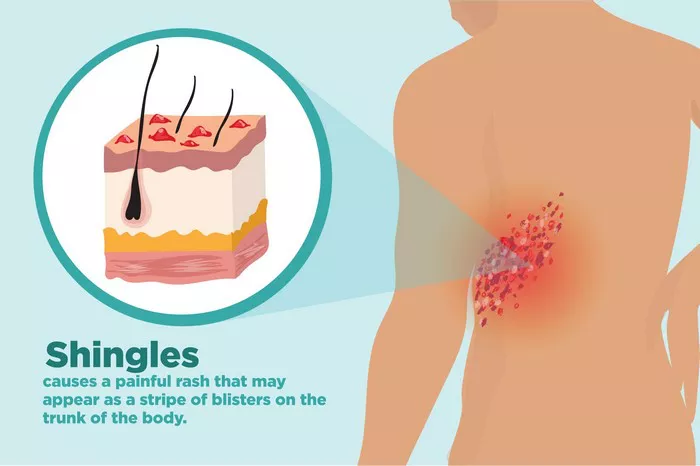Shingles is a viral infection that affects the skin and nerves. It is caused by the same virus that causes chickenpox—known as varicella-zoster virus (VZV). After you recover from chickenpox, the virus remains dormant in your body. Later in life, the virus can become active again and cause shingles. This article will help you understand what shingles is, how it affects the body, its symptoms, complications, treatment options, and prevention methods.
What is Shingles?
Shingles is a painful skin rash that usually appears on one side of the body. It is a reactivation of the varicella-zoster virus, which remains dormant in the body’s nerve tissues after a chickenpox infection. When the virus reactivates, it travels along nerve fibers to the skin, causing a rash and other symptoms.
Unlike chickenpox, which can affect anyone who has never had it or been vaccinated against it, shingles typically affects adults, particularly those over the age of 50 or individuals with weakened immune systems.
How Does the Shingles Virus Reactivate?
After you have had chickenpox, the varicella-zoster virus stays in your body, specifically in the nerve cells near your spinal cord and brain. It remains inactive for years. However, something can trigger the virus to become active again. The exact cause of reactivation is unclear, but certain factors increase the risk, such as:
Aging: The immune system weakens as you age, making it more difficult to keep the virus dormant.
Stress: High levels of stress can weaken the immune system, triggering the reactivation of the virus.
Weakened Immune System: Conditions such as HIV/AIDS, cancer treatments like chemotherapy, and medications that suppress the immune system can make you more likely to develop shingles.
Previous Chickenpox Infection: Anyone who has had chickenpox is at risk, even if they are healthy.
Symptoms of Shingles
Shingles symptoms typically begin a few days before the rash appears. The first signs may include:
Pain, Burning, or Tingling Sensation: Often, the skin will feel unusually sensitive in a certain area, typically on one side of the torso, face, or neck.
Itching: The affected area may start to itch before the rash shows up.
Fever: A mild fever may develop, although it is not always present.
Headache: Some people experience headaches as the virus starts to reactivate.
Fatigue: Feeling tired and weak is common during the early stages of shingles.
Once the rash develops, it typically appears as a cluster of red spots that become fluid-filled blisters. These blisters are usually painful, and they eventually dry up and form scabs. The rash usually appears on one side of the body, following a band-like pattern along the nerves.
How Shingles Affects the Body
Shingles primarily affects the skin and nerves. Here’s how it works:
Nerve Involvement: The varicella-zoster virus reactivates within the nerve cells, where it causes inflammation and damage to the nerves. This leads to pain, which can range from mild to severe.
Rash and Blisters: As the virus spreads along the nerves, it causes a rash with blisters that can be very painful. The blisters eventually break open and crust over.
Postherpetic Neuralgia (PHN): After the rash clears up, some people may continue to experience pain in the affected area. This condition is known as postherpetic neuralgia, and it is one of the most common complications of shingles. The pain can last for weeks, months, or even years.
Complications of Shingles
While most people recover from shingles without any serious problems, there are complications that can arise. These include:
1. Postherpetic Neuralgia (PHN)
Postherpetic neuralgia is a condition where nerve pain persists long after the rash has healed. The pain can be severe and may feel like a burning, stabbing, or aching sensation. PHN can last for months or even years and is most common in people over 60.
2. Vision Problems
If shingles affects the eye, it can cause serious vision problems. This is called ophthalmic shingles, and it occurs when the virus affects the ophthalmic nerve, which supplies the eye. It can lead to conditions like eye infections, glaucoma, or permanent vision loss if not treated promptly.
3. Neurological Problems
In rare cases, shingles can lead to more serious neurological complications, including:
Meningitis: Inflammation of the protective membranes around the brain and spinal cord.
Encephalitis: Inflammation of the brain itself, which can cause symptoms like confusion, seizures, and trouble moving.
Hearing Loss: If shingles affects the nerves in the ear, it can result in hearing problems.
4. Skin Infections
The blisters caused by shingles can become infected with bacteria. If this happens, it may lead to further complications, such as cellulitis or a deeper skin infection that requires antibiotics.
5. Scarring
In some cases, the rash caused by shingles can leave permanent scars. This is more common if the blisters become infected or if the rash is severe.
Treatment for Shingles
While there is no cure for shingles, treatment can help reduce the severity of the symptoms and speed up the healing process. Common treatments for shingles include:
1. Antiviral Medications
Doctors usually prescribe antiviral medications to reduce the severity of the infection and shorten the duration of the symptoms. The most common antiviral drugs for shingles are acyclovir, valacyclovir, and famciclovir. These medications are most effective when taken early in the course of the illness, preferably within 72 hours of the appearance of the rash.
2. Pain Relief
Pain management is an important part of shingles treatment. Over-the-counter pain relievers such as acetaminophen or ibuprofen can help reduce mild pain. For more severe pain, doctors may prescribe stronger medications, such as opioids or certain types of antidepressants and anticonvulsants that help relieve nerve pain.
3. Topical Treatments
Creams or ointments containing calamine or lidocaine may help relieve itching and discomfort associated with the rash. Cooling gels or baths may also provide some relief.
4. Corticosteroids
In some cases, corticosteroids may be prescribed to reduce inflammation and swelling. However, these are usually reserved for severe cases, as they can weaken the immune system.
Preventing Shingles
There are steps you can take to reduce your risk of developing shingles, including:
1. Shingles Vaccine
The shingles vaccine, known as Shingrix, is the most effective way to prevent shingles. It is recommended for adults aged 50 and older, even if they have already had shingles before. The vaccine reduces the risk of developing shingles and helps prevent complications like postherpetic neuralgia. The vaccine is given in two doses, typically spaced two to six months apart.
2. Good Immune Health
Maintaining a healthy immune system can also help reduce the risk of shingles. This includes eating a balanced diet, exercising regularly, managing stress, and getting enough sleep. If you are over the age of 50 or have a weakened immune system, talk to your doctor about getting vaccinated.
3. Early Treatment
If you do develop shingles, getting prompt medical treatment can help reduce the severity of the disease and lower the risk of complications. Antiviral medications are most effective when started early.
Conclusion
Shingles is a viral infection that can cause pain, discomfort, and complications, especially in older adults or those with weakened immune systems. It is caused by the varicella-zoster virus, the same virus responsible for chickenpox. The virus remains dormant in the body after a chickenpox infection and can reactivate later in life, causing a painful rash and sometimes lasting nerve pain.
While shingles cannot be cured, antiviral medications and pain relief treatments can help manage the symptoms and prevent complications. The best way to protect yourself from shingles is to get vaccinated, particularly if you are over the age of 50. If you experience symptoms of shingles, such as a painful rash, it’s important to seek medical treatment as soon as possible to reduce the risk of complications.
Related topics:



























